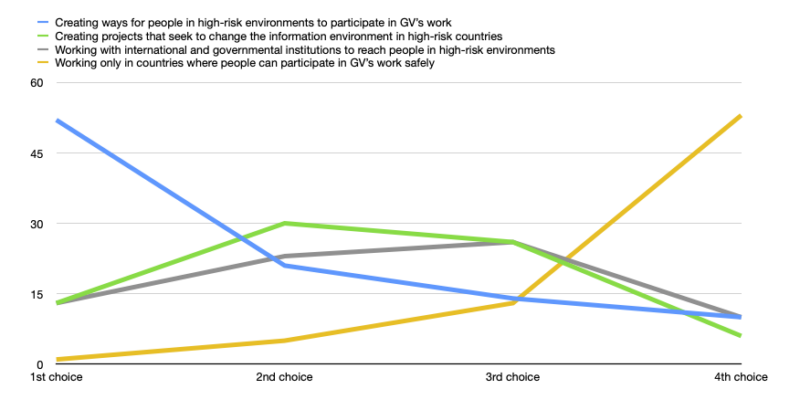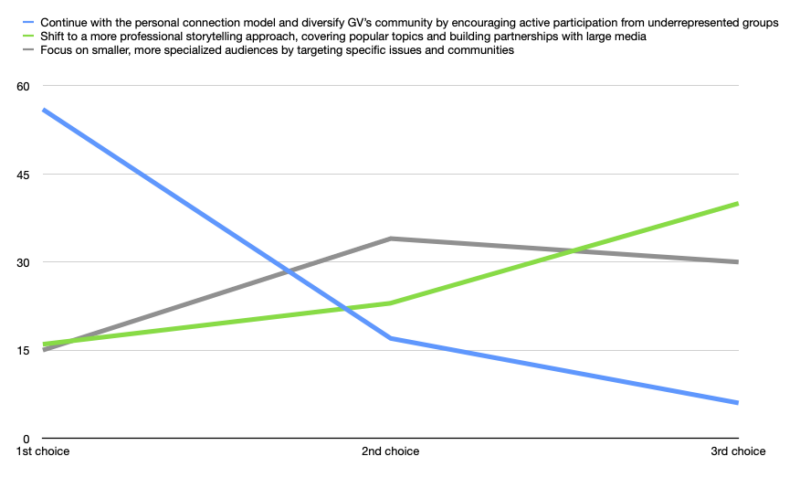This year’s poll contains rich detail about the ideas and preferences of Community Council members for our mission and strategy.
Full results are available in a recent post [1], which also offers several ways to visualize the responses. In this post, we’ll explore the data in detail, and also look at the anonymized free text responses, which are available in a public spreadsheet [2].
The poll comprised three questions arising out of the 2022 Issue Paper [3], which explored key questions related to the Global Voices mission of “building understanding across communities [4]”: Challenges to understanding; What motivates understanding; Defining and measuring understanding.
We used a ranked choice [5] poll, which allows us explore nuances in the data. We can compare both most popular and least popular options, and also whether respondents are polarized on a given issue.
Question 1: Challenges to understanding
The first poll question asked Council members to complete the statement: “When we find ourselves operating in difficult political and rights situations, we should aim to build understanding by—”
The clear winner was “Creating ways for people in high-risk environments to participate in GV’s work,” with 54% of respondents selecting it as their 1st choice, and only 1% choosing it as their last choice.
The option to “Create projects that seek to change the information environment in high-risk countries” was a strong second throughout the ranking, and also received a lot of support in the comments. The option to “Work with international and governmental institutions to reach people in high-risk environments” was a consistent 3rd place, and numerous commenters noted we should be careful not to compromise our values.
The least popular option, “Working only in countries where people can participate in GV’s work safely,” was selected as the 1st choice by only 10% of respondents, and was selected as the last choice by 74%.
Responses to this question were not polarized, as the following graph shows. The most popular option in the first rank also scored the lowest in the last rank, and this correlation occurred through the entire range of choices.

The free text responses provide additional insight. A typical response:
“GV represents a unique platform (and community) that pays attention to situations and people often ignored or misrepresented by global mainstream media in major languages. In my view this represents the most precious part of the work we do….Working only in safe countries would diminish our role…”
Taken together we can draw lessons from these responses: focus first on people as individuals and communities; work everywhere, including risky environments, as a core value of GV; build strategic partnerships where possible and only in line with our own mission and ends.
Question 2: What motivates understanding
The second poll question asked Council members to complete the statement “To promote understanding and increase our impact, GV should—”
The option “Continue with the personal connection model and diversify GV’s community by encouraging active participation from underrepresented groups” is our current theory of change and was by far the most popular: 64% ranked it 1st and only 8% ranked it last.
The responses to other options were also consistent. The option “Shift to a more professional storytelling approach, covering popular topics and building partnerships with large media” was ranked 1st by 18% of respondents, while 53% chose it as their 3rd choice. The option of focusing on smaller, more professional audiences was the worst performer for the first choice, but was the most popular second choice.

In the text responses, most respondents strongly support the personal connection aspect of GV:
“GV should become a sharing community where we employ free transfer of knowledge (in journalism, activism, critical and creative thinking). We need to create procedures where “citizen journalists” are professional, [and] adherent of principles of journalism and free speech.”
Several comments support the idea of high-quality editing and production built atop personal connection, together with partnerships with professional mass media. Curiously, while the focus on smaller, more specialized audiences did reasonably well in the polling, many of the written comments noted that this approach risks making GV less “global”.
Question 3: Defining and measuring “understanding”
The third poll question asked Council members to complete the statement “To create a Global Voices branding of ‘understanding’ we should—”
The option “Identify the “understanding” element of our projects, and build explicit goals and outcomes based on that,” won a plurality: 44% placed it 1st while 13% placed it last. The option “Continue to use the concept of understanding as a broad goal,” did the worst, with 23% placing it first and 56% placing it last.
This question also generated interesting nuances. The most popular option did not receive a majority, but it was the last choice for very few people. The second choice, “Global Voices approach to understanding” as a brand to represent our work,” placed 2nd at every ranking. Support for understanding as a broad goal was most evenly divided, with 1/3 choosing it as their first choice, and another 1/3 choosing as their last choice, with numerous negative comments.

We received especially rich and useful insight in free text responses:
“I think it's useful to have a clear and explicit view of our goals that we, as members, can help promot[e]. People are more likely to be interested and engage in work that they can easily understand how it's done and think of ways to apply it to their lives. This is best achieved by having a definition of understanding of our own that makes our work more tangible and also helps contributors to create content that is aligned with GV’s values.”
Many commenters support the idea of defining “understanding.” Some note that the implicit definition in much of GV’s work is different from what is laid out in the Issue Paper, which focuses on mutual acknowledgment of different positions. If we adopt this definition, we might also need new programmatic approaches. Many people also suggested that we need a defined that can be measured or at least evaluated systematically.
In sum, the poll results provide clear indications for how we might build understanding. It affirms many of our existing values and directions, and also challenges us to better define and brand by what we mean as “understanding,” so that we might know when we’ve achieved it.